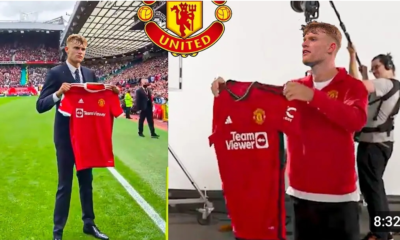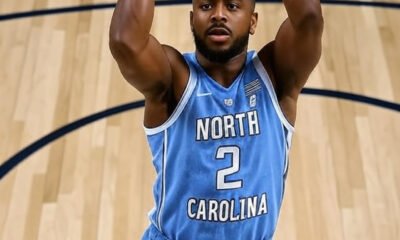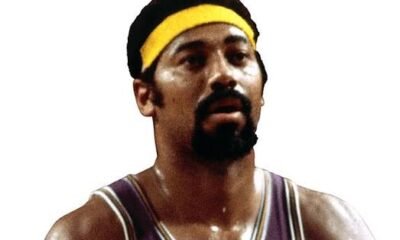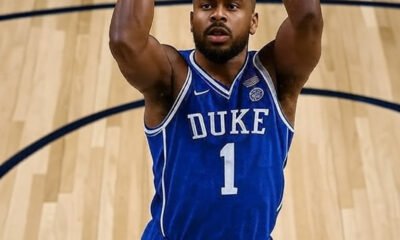Blog
Harris, No.1 Georgia Bulldogs target, stands 7-foot-tall committs to Ole Miss football over Georgia….
Harris, No. 1 Georgia Bulldogs Target, Stands 7-Foot-Tall, Commits to Ole Miss Over Georgia
In a surprising turn of events, five-star center Harris, once considered the top prospect for the Georgia Bulldogs, has committed to Ole Miss, choosing the Rebels over his hometown school, Georgia. Standing at an imposing 7 feet tall, Harris’s decision has sent shockwaves through the college football recruiting landscape and raises questions about the future of Georgia’s recruiting strategy.*
—
### Introduction
The college football recruiting scene is always dynamic, filled with surprises, and often unpredictable. This year, one of the most talked-about prospects has been Harris, a towering 7-foot athlete who was widely regarded as the No. 1 target for the Georgia Bulldogs. Hailing from a high school in Georgia, Harris’s decision to commit to Ole Miss represents a significant shift and underscores the changing priorities in recruiting, as well as the increasing prominence of the SEC’s competitive landscape.
### Background of Harris
Harris, a highly touted prospect, has garnered national attention for his exceptional size, athleticism, and skill set. At 7 feet tall, he possesses an unusual combination of length, agility, and basketball-like coordination that makes him a versatile threat on both sides of the ball — whether at linebacker, defensive tackle, or even tight end. His physical attributes have drawn comparisons to some of the most dominant big men in college football history.
During his high school career, Harris demonstrated a rare blend of dominance and athleticism, often overwhelming opponents with his size and quickness. His highlight reels showcase him collapsing the pocket, swatting passes, and making explosive plays that belie his size.
### Recruitment Journey
Initially, Harris was considered a lock to join the Georgia Bulldogs, given his roots in the state and Georgia’s longstanding tradition of recruiting local talent. The Bulldogs had prioritized him heavily, offering a scholarship early and showcasing their commitment to keeping him home.
However, as the recruitment process unfolded, Harris expressed interest in exploring options beyond Georgia. He visited several schools, including Ole Miss, Alabama, and LSU, but maintained a close relationship with Georgia coaches. Despite this, Ole Miss’s coaching staff, led by head coach Lane Kiffin, made a compelling pitch emphasizing immediate playing time, a high-powered offense, and a vision for developing his talents.
### The Decision to Commit to Ole Miss
In a surprising twist, Harris announced his commitment to Ole Miss, choosing the Rebels over Georgia. This decision was announced via social media, where Harris posted a heartfelt message explaining his choice.
**Key factors influencing his decision include:**
– **Playing Time and Opportunity:** Ole Miss presented a clearer pathway to immediate playing time, which was a significant consideration for Harris. The Rebels have been known for developing young talent and giving freshmen opportunities early in their careers.
– **Coaching Staff and Development:** Lane Kiffin’s reputation as an innovative offensive mind and a developer of talent played a crucial role. Harris expressed confidence in the coaching staff’s ability to maximize his potential.
– **Program Vision:** Ole Miss’s commitment to building a competitive team in the SEC and their strategic plan for the future resonated with Harris. The Rebels’ recent success and upward trajectory made them an attractive destination.
– **Personal Connections:** Harris also cited strong relationships with Ole Miss assistant coaches, who made him feel valued and prioritized during the recruitment process.
### Georgia’s Perspective and Impact
Georgia, a perennial powerhouse with a national championship pedigree, was undoubtedly disappointed by losing Harris. The Bulldogs have emphasized their focus on local talent and have built their recruiting success on securing top prospects from Georgia and neighboring states.
Losing Harris, especially to a SEC rival, is a setback but also a wake-up call. Georgia’s coaching staff will need to reassess their recruiting approach and perhaps focus on developing other prospects to fill the void.
This development also raises questions about Georgia’s defensive line and overall roster strategy. Harris’s size and athleticism could have complemented Georgia’s existing front seven, which already boasts talented players like Jalen Carter and Jordan Davis (who has moved on to the NFL).
### Ole Miss’s Recruitment Gains
Ole Miss’s ability to land Harris signals a strategic shift for the Rebels. With Lane Kiffin at the helm, Ole Miss has aggressively targeted top-tier talent to elevate their program’s stature in the SEC.
Harris’s commitment is a significant win for Ole Miss, both on the field and in recruiting rankings. It demonstrates their ability to compete with traditional powerhouses like Georgia, Alabama, and LSU for elite prospects.
Furthermore, Harris’s presence on the roster is expected to boost Ole Miss’s defensive line, providing a potential game-changing interior presence. His size and athleticism could make him a focal point for the Rebels’ defensive schemes.
### Broader Implications for College Football
Harris’s decision highlights several broader themes in college football recruiting:
1. **Changing Recruiting Dynamics:** Prospects are increasingly prioritizing immediate opportunities, coaching staff relationships, and program vision over traditional loyalties or location.
2. **SEC Competition Intensifies:** With more programs in the SEC investing heavily in recruiting top talent, traditional powerhouses like Georgia must adapt to keep top prospects home.
3. **Player Development and NIL Influence:** While not explicitly stated, the rise of NIL (Name, Image, Likeness) deals influences recruiting decisions. Programs offering lucrative opportunities or strong brand-building platforms can sway prospects.
4. **Impact on Georgia’s Future:** Losing a No. 1 target to a rival underscores the importance of recruiting excellence and building a pipeline of talent to sustain dominance.
### Future Outlook
For Harris, the next few years will be critical in developing his skills at Ole Miss. If he lives up to his potential, he could become a dominant force in college football and potentially a high NFL draft pick.
For Georgia, the focus shifts to other prospects and continuing to build a competitive roster. They will undoubtedly aim to rebound and secure top-tier talent in future cycles.
Ole Miss, on the other hand, now has a marquee player that can energize their fan base and elevate their national profile. Harris’s development could be pivotal in their quest to contend in the SEC and beyond.
### Conclusion
Harris’s decision to commit to Ole Miss over Georgia marks a significant moment in college football recruiting. It exemplifies the shifting priorities of top prospects, the increasing competitiveness within the SEC, and the importance of strategic relationships and opportunities in shaping the future of college football.
While Georgia may have lost a prized target, the landscape remains fluid, and the coming seasons will reveal how these recruiting battles reshape the power dynamics in college football. Harris’s journey is just beginning, and all eyes will be on how he leverages this opportunity to make a mark at Ole Miss and beyond.
-

 Arsenal2 years ago
Arsenal2 years agoSad News Arsenal ex player who is goal scorer confirmed dead this morning
-

 Liverpool2 years ago
Liverpool2 years agoSad News Sadio Manè Confirmed Dead Today By Sky Sports Reporters, Open For Full Story 👇
-

 Blog1 year ago
Blog1 year ago“I was forcefully removed from Manchester United squad and now I’ve joined the best team in the world…I will revenge and as a result, I’ve ordered my friend who’s their best player currently to leave there with immediate effect and he has agreed”: Former Man United player angered by United decision to removed him from the squad as he ordered the Club’s best player to leave immediately.
-

 Blog1 year ago
Blog1 year agoSad News: Manchester United player died when playing for his country England yesterday 😢 😔
-

 Blog2 years ago
Blog2 years agoR.I.P: Formal Real Madrid and France international confirm death this morning
-

 Chelsea2 years ago
Chelsea2 years agoBreaking New:”Roman Abramovich could get Chelsea back”? Chelsea owner review the conversation between him and Roman Abramovich in. Deal about getting Chelsea back
-

 Blog2 years ago
Blog2 years agoUNBELIEVABLE: Manchester City midfielder KELVIN DE BRUYNE divorced wife this morning after DNA test revealed their 5 years old son belongs to formal Manchester United player
-

 Manchester United1 year ago
Manchester United1 year agoOFFICIAL NOW: Manchester United announce the signing of 23yr sensational player after beating Liverpool and Madrid for His signature, agreement reached on a 5yr deal, Medical completed – announcement ongoing












